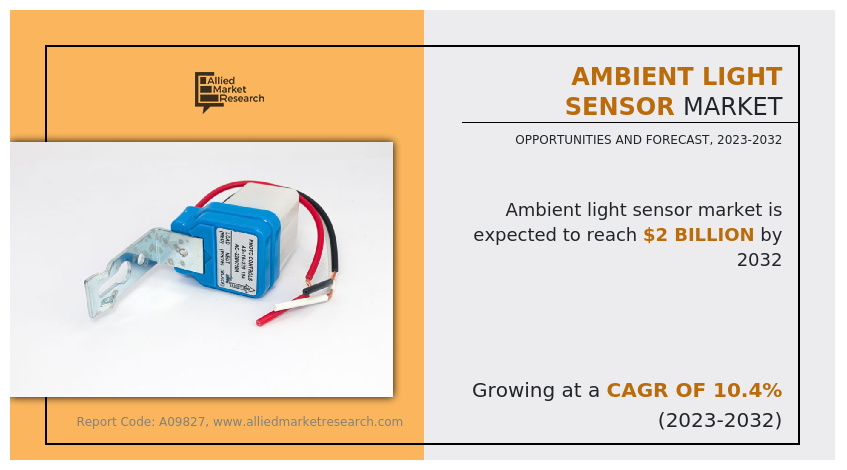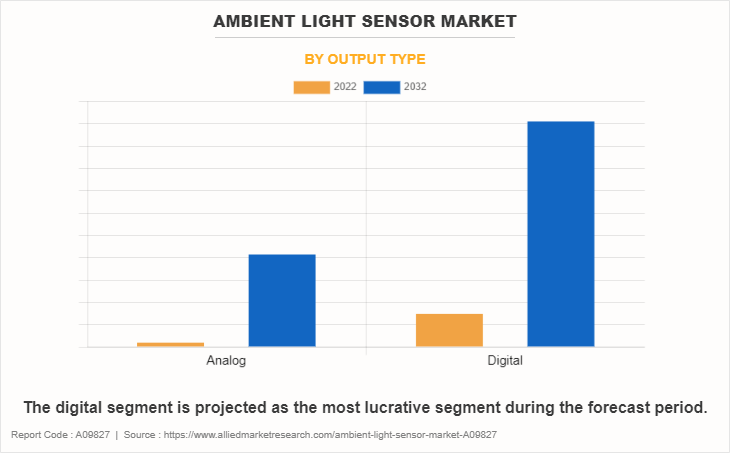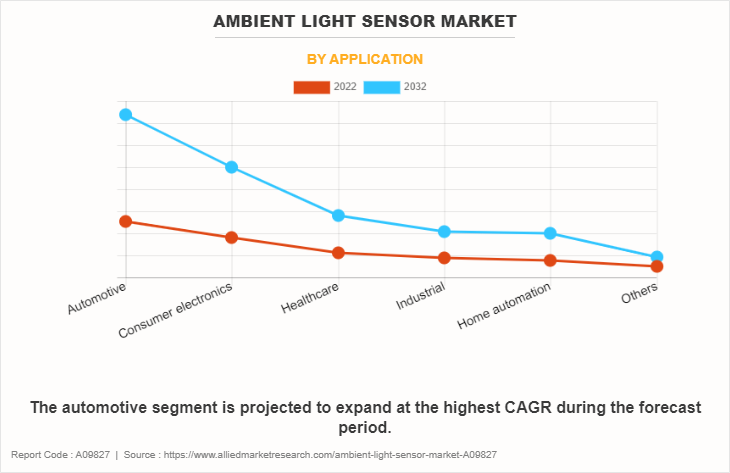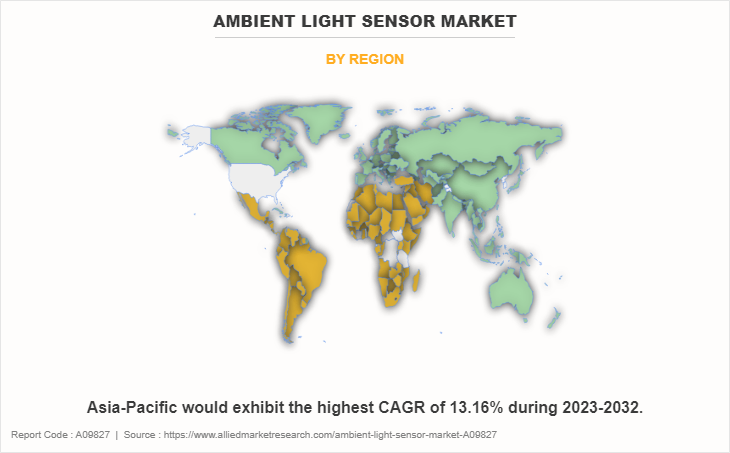Ambient Light Sensor Market Research, 2032
The Global Ambient Light Sensor Market was valued at $761 million in 2022, and is projected to reach $2 billion by 2032, growing at a CAGR of 10.4% from 2023 to 2032.
An ambient light sensor is an environmental light detector. It is also known as an ALS or a photodetector. Numerous consumer devices and industrial applications frequently use this sensor. Their main roles include automatically adjusting the brightness of screens, controlling lighting systems, and executing a variety of tasks that depend on the prevailing lighting conditions around them. For instance, they are used in smartphones and laptops for screen brightness adjustment, in digital cameras for setting exposure levels, and in smart home systems for lighting control.
These sensors generally operate on the principles of photoconductivity or photodiode technology. They generate electrical signals proportional to the intensity of incident light, with changes in light levels resulting in variations in electrical resistance or current, thus measuring the light level. Ambient light sensors have a broad range of applications. In devices such as smartphones and laptops, they adjust screen brightness for optimal visibility and power conservation in different lighting conditions. They enhance energy efficiency in smart lighting systems by automatically dimming or turning off lights in response to natural daylight. Digital cameras use these sensors to set exposure times and apertures for properly exposed photos. In smart homes, they trigger actions such as adjusting blinds, turning on lights, or altering lighting color temperature based on the time of day and ambient light. In addition, in industrial settings, these sensors are employed for tasks such as quality control in manufacturing or sorting objects by color.

Segment Overview
The ambient light sensor market is segmented into Output Type and Application.

By output type, the market is bifurcated into analog, and digital.

By application, the ambient light sensor industry is fragmented into consumer electronics, automotive, healthcare, industrial, home automation, and others.

By region, the market is analyzed across North America (the U.S., Canada, and Mexico), Europe (the UK, Germany, France, and rest of Europe), Asia-Pacific (China, Japan, India, South Korea, and rest of Asia-Pacific) and LAMEA (Latin America, Middle East, and Africa).
During the projection period of 2023-2032, the US has acquired a considerable ambient light sensor market share in the North American region. This dominant position is primarily due to the country's excellent technical infrastructure, as well as the existence of prominent tech businesses and significant investments in breakthrough technology. The US market benefits from a significant emphasis on developing and integrating cutting-edge technology in industries like as automotive and consumer electronics. Additionally, the swift uptake of smart home technologies and IoT devices, coupled with the nation's focus on energy-saving and sustainable practices, boosts the demand for ambient light sensors, further cementing its position as a market leader.
In Europe, Germany has solidified its position as a dominant player in the ambient light sensor market in terms of revenue share in 2022, and this trend is anticipated to continue throughout the forecast period. Germany's leading position in the ambient light sensor market is due to its solid industrial foundation, particularly in the automotive industry where these sensors are extensively utilized. As the host to several top global automotive manufacturers, Germany is at the forefront of incorporating ambient light sensors into sophisticated vehicle technologies to improve safety and comfort. Moreover, the country's dedication to technological advancement and its strong electronics sector are key contributors. Germany's emphasis on embracing and developing advanced, smart, and energy-efficient systems also significantly propels the demand for ambient light sensors, sustaining its status as a market leader.
China is expected to become a significant player in the ambient light sensor market in the Asia-Pacific region. This anticipated growth stems from its extensive electronics manufacturing industry and swift advancements in technology. Being a leading center for electronic production globally, China is incorporating ambient light sensors into a broad spectrum of products, including everything from smartphones to smart home systems. The nation's increasing commitment to smart city developments and energy-efficient technologies is also driving the demand for these sensors. Moreover, China's vast consumer base, combined with a vigorous pursuit of innovation in fields such as automotive and consumer electronics, is further catalyzing the expansion of the ambient light sensor industry, solidifying its role as a major market in the region.
In the LAMEA region, Latin America has established itself as the dominant player in the ambient light sensor market by securing the highest revenue share in 2022. This dominant market position stems from the escalating use of cutting-edge technologies in the consumer electronics and automotive industries in Latin America. There has been a noticeable rise in the region's demand for smartphones, tablets, and smart home appliances, most of which commonly include ambient light sensors. Additionally, the automotive industry in Latin America is progressively integrating these sensors for enhanced vehicle functionality and safety. The emphasis on technological advancement in the region, along with the growing middle-class consumer segment keen on adopting the newest technological products, has played a substantial role in the expansion and prominence of the ambient light sensor market in Latin America.
Ambient light sensors, which are also employed in portable ambient light settings, are available in different types, including photodiodes, phototransistors, and integrated sensor modules. While some are capable of sensing a wide spectrum of light wavelengths, others are tailored to detect particular kinds of light, such as infrared or ultraviolet. Manufacturers frequently provide calibration data or prescribe specialized calibration techniques to compensate for variances in sensor performance, ensuring reliable and precise readings in a variety of applications, including portable ambient light settings.
The ambient light sensor market has gained significant momentum due to its expanding utilization across various electrical applications, particularly in energy-saving initiatives. These sensors play a pivotal role in automatically adjusting the brightness of streetlights, traffic signals, and both outdoor & indoor lighting systems in accordance with the prevailing ambient light levels. A prime example is their implementation in smart city projects, where ambient light sensors seamlessly dim streetlights during the night when ambient light levels are low, leading to reduced energy consumption. Similarly, in office buildings and homes, ambient light sensors effectively manage the brightness of indoor lighting, ensuring that lights are activated or dimmed only to the requisite level. This intelligent lighting control promotes energy efficiency and aligns with environmental sustainability goals. Such applications underscore the growing indispensability of ambient light sensors in modern electrical systems, thereby driving ambient light sensor market demand.
However, the higher cost of ambient light sensors, particularly those with advanced features and high performance, act as a deterrent in certain markets, impacting the growth prospects of the ambient light sensor market. In consumer electronics sectors where affordability is paramount, incorporating high-cost ambient light sensors significantly raises the price of devices, potentially discouraging budget-conscious consumers. This challenge is particularly evident in the manufacturing of budget-friendly smartphones and other economical electronics. Here, producers must strike a delicate balance between the sensor's quality and the device's cost-effectiveness, a balancing act that affects the overall appeal and marketability of these products. Consequently, the higher expense associated with these sensors restricts their use in segments where affordability is crucial, thereby affecting the broader adoption of ambient light sensor market growth.
Despite this restraint, the increase in adoption of ambient light sensors in emerging device categories such as wearable electronics and augmented reality (AR) devices represents a considerable growth potential for the ambient light sensor market. These innovative devices utilize ambient light sensors to tailor their functionality and user experience according to different lighting environments. For instance, wearable fitness trackers utilize ambient light sensors to adjust display brightness and enhance outdoor visibility. Similarly, AR devices employ ambient light sensors to optimize their virtual overlays and ensure a seamless blending of digital content with the real world. This increase in the integration of ambient light sensors into new device categories is expected to drive demand and accelerate market growth.
Top Impacting Factors
The ambient light sensor market is expected to witness notable growth owing to an increase in demand for smartphones and consumer electronics and the growing adoption of automotive displays. Moreover, the development of new sensor technologies is expected to provide a lucrative opportunity for the growth of the market during the forecast period. On the contrary, low current output limits the growth of the ambient light sensor market.
Competitive Analysis
The ambient light sensor market outlook report highlights the highly competitive nature of the ambient light sensor market, owing to the strong presence of existing vendors. Vendors with extensive technical and financial resources are expected to gain a competitive advantage over their counterparts by effectively addressing market demands. The competitive environment in this market is expected to increase as product launches, new product development, and collaboration kind of strategies adopted by key vendors increase. Competitive analysis and profiles of the major Ambient light sensor market players that have been provided in the report include ams-OSRAM AG, Acuity Brands, Inc., Broadcom Ltd., ON Semiconductor Corporation, Panasonic Corporation, Renesas Electronics Corporation, ROHM Co., Ltd., STMicroelectronics N.V., Texas Instruments Incorporated, Vishay Intertechnology, Inc.
Key Developments/ Strategies
According to the latest ambient light sensor market forecast, Panasonic Corporation, ams-OSRAM AG, Vishay Intertechnology, Inc., Broadcom Ltd., and Texas Instruments Incorporated are the top 5 players in the ambient light sensor market. Top market players have adopted various strategies, such as product launches, new product development, and collaboration to expand their foothold in the ambient light sensor market.
January 2022 - Panasonic launched a flagship OLED TV, the LZ2000. The TV is available in 55-inch, 65-inch, and 77-inch sizes. It features a new ambient light sensor that adjusts the picture quality based on the time of day. The TV also has a new Auto AI mode that detects the type of content being watched and optimizes the picture and sound quality accordingly
October 2021 - Vishay Intertechnology launched a new AEC-Q100 qualified ambient light sensor, the VEML6031X00, designed for automotive and consumer applications requiring high sensitivity in dark environments. It offers exceptional light detection from 0 lx to 228 klux without needing correction formulas, making it ideal for applications like display backlight control, infotainment systems, and interior lighting. The VEML6031X00 caters to a wide range of markets, from automotive to telecommunications and medical industries.
January 2021 - At CES 2021, Panasonic showcased an AI-powered refrigerator that features an ambient light sensor as an integral part of its Econavi technology. This innovative sensor enables the refrigerator to dynamically adjust its cooling performance based on the ambient light levels, ensuring optimal internal temperatures and maximizing energy savings. This breakthrough demonstrates Panasonic's dedication to integrating cutting-edge sensor technology into its home appliances, fostering enhanced energy efficiency and user satisfaction.
Key Benefits for Stakeholders
This study comprises analytical depiction of the ambient light sensor market size along with the current trends and future estimations to depict the imminent investment pockets.
The overall ambient light sensor market analysis is determined to understand the profitable trends to gain a stronger foothold.
The report presents information related to key drivers, restraints, and ambient light sensor market opportunities with a detailed impact analysis.
The ambient light sensor market forecast is quantitatively analyzed from 2022 to 2032 to benchmark financial competency.
The Porter's five forces analysis illustrates the potency of the buyers and suppliers in the ambient light sensor market.
The report includes the share of key vendors and Ambient Light Sensor Market trends.
Ambient Light Sensor Market Report Highlights
| Aspects | Details |
| Market Size By 2032 | USD 2 billion |
| Growth Rate | CAGR of 10.4% |
| Forecast period | 2022 - 2032 |
| Report Pages | 286 |
| By Output Type |
|
| By Application |
|
| By Region |
|
| Key Market Players | Vishay Intertechnology, Inc., STMicroelectronics N.V., ON Semiconductor Corporation, Panasonic Corporation, ams-OSRAM AG, Broadcom Ltd., ROHM Co., Ltd., ACUITY BRANDS, INC., Texas Instruments Incorporated, Renesas Electronics Corporation |
Analyst Review
The ambient light sensor market is witnessing substantial expansion, primarily due to its increasing application across various industries. Ambient light sensors are becoming more prevalent in consumer electronics, especially in devices such as laptops, smartphones, tablets, where they play an important role in automatically changing screen brightness. This not only enhances the user experience, but it also saves battery life. Adoption of these sensors in the automobile industry is increasing for applications like as interior illumination and dashboard displays, matching with the trend of moving towards smarter, autonomous cars.
Additionally, the expansion of smart home technologies and the Internet of Things (IoT) has led to a higher demand for ambient light sensors in home automation systems, particularly for energy-efficient and responsive lighting solutions. The growing global focus on energy conservation and environmental sustainability further boosts this demand, as ambient light sensors play a crucial role in optimizing energy usage in lighting. Emerging markets are also contributing to the market growth, with rapid technological adoption and an increasing consumer base. Collectively, these factors are driving the ambient light sensor market towards a significant and sustained period of growth.
Some of the key players profiled in the study include ams-OSRAM AG, Acuity Brands, Inc., Broadcom Ltd., ON Semiconductor Corporation, Panasonic Corporation, Renesas Electronics Corporation, ROHM Co., Ltd., STMicroelectronics N.V., Texas Instruments Incorporated, Vishay Intertechnology, Inc. These players have adopted various strategies such as product launches, new product development, innovation, agreement, and collaboration to increase their market penetration and strengthen their position in the ambient light sensor industry.
The industry size of Ambient Light Sensor is estimated to be $761.04 million in 2022.
North America is the largest regional market for Ambient Light Sensor
The automotive sector takes the lead as the primary application of the Ambient Light Sensor Market.
Panasonic Corporation, ams-OSRAM AG, Vishay Intertechnology, Inc., Broadcom Ltd., and Texas Instruments Incorporated are the top 5 companies to hold the market share in Ambient Light Sensor.
The upcoming trends in the global ambient light sensor market include increased integration in smart devices and vehicles, advancements in IoT applications, and a growing focus on energy-efficient and sustainable technology solutions.
Loading Table Of Content...
Loading Research Methodology...



